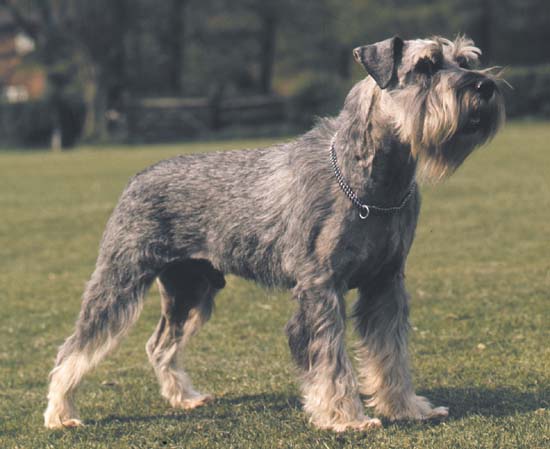
The Breed History
This breed is the original Schnauzer dog from which the Giant
and Miniature were developed. The records of origin trace back to
Germany in the year 1500, though they are depicted in artwork
around the mid 1400s. Bavaria and Wurtemmburg are regions that
provide earliest records of the breed type. The genealogy of the
breed is thought to include Dog de Bologne, Wirehaired Pincher,
black German Poodle, and gray Wolf Spitz. The first breed standard
was published in 1880. AKC recognition occurred in 1904.
Breeding for Function
Vermin control and guard dog were the original functions that this
breed was developed for. A fearless temperament was valued highly.
Because of their obedience and tenacity, they were widely used in
war for dispatch and aides, as well as for police work. Versatile, they
have even been used for water retrieving work and sheep herding.
Physical Characteristics
Height at Withers: female 17.5-18.5" (44.5-47 cm), male
18.5-19.5" (47-49.5 cm).
Weight: males 40-45 lb (18-20.5 kg), females 35-40 lb (16-18 kg).
Coat: They possess a double coat consisting of a soft undercoat
and outer hairs that are stiff, wiry and tight. The coat is ideally
maintained by stripping not clipping. Salt and pepper is most
common (mixture of hairs with bands of white and black mixed with
black hairs and white hairs) but solid black is also sometimes seen.
Longevity: 12-14 years
Points of Conformation: Bushy bristling brows, substantial beard,
wiry coat, a compact, square conformation, and abundant whiskers
characterize the Standard Schnauzer. Heavy muscling and bone, and
alert, high head carriage is also characteristic. The head is rectangular
in shape. There is a flat moderately broad skull, and a slight stop. The
eyes are medium in size, oval, and dark brown in color. Medium-sized
ears are triangular, high set and the leather is moderate. Sometimes
the ears are cropped. The nose is black and large. The neck is of
moderate length and arched, and no throatiness should be evident.
The topline is straight, descending very slightly towards the rear.
The thorax is medium in depth, and ribs are well sprung. Moderate
abdominal tuck up is present and the tail is short, usually docked
to 1-2" (2.5-5 cm) length. Limbs are straight boned, moderately
muscled, and forelimb dewclaws may be removed. Feet are small, and
toes are well arched, with thick pads and black nails. Rear dewclaws
are generally taken off. The gait is quick, smooth and true.
Recognized Behavior Issues and Traits
Reported breed characteristics include: High intelligence, a good
guard dog, devoted, reliable, sociable, good trainability, excellent
endurance. High grooming needs, including at least a twice yearly
stripping and daily grooming of whiskers and legs is necessary. The
stripped coat is low shedding. Good for city or country settings,
and generally good with children. Spirited temperament may
result in an effort to dominate the household. Active dogs, they
are in need of moderate exercise. These dogs do not do well in
kennel situations; needing mental stimulation to prevent boredom.
They have a moderate barking tendency. Early socialization and
obedience training is important.
Normal Physiologic Variations
None reported
Drug Sensitivities
None reported
Inherited Diseases
Hip Dysplasia: Polygenically inherited trait causing degenerative
joint disease and hip arthritis. OFA reports 8.6% affected.
Elbow Dysplasia: Polygenically inherited trait causing elbow arthritis.
OFA reports 6.1% affected.
Patella Luxation: Polygenically inherited laxity of patellar ligaments,
causing luxation, lameness, and later degenerative joint disease. Treat
surgically if causing clinical signs. Too few Standard Schnauzers have
been screened by OFA to determine an accurate frequency.
Disease Predispositions
Hypothyroidism: Inherited autoimmune thyroiditis. 7.0% positive
for thyroid autoantibodies based on testing at Michigan State
University. (Ave. for all breeds is 7.5%).
Pancreatitis: Inflammation of the pancreas causing vomiting. In
extreme cases, can cause peritonitis and require hospitalization.
Dorn reports a 55.06x odds ratio versus other breeds.
Diabetes Mellitus: Sugar diabetes. Treat with insulin injections,
diet, and glucose monitoring. Dorn reports a 10.01x odds ratio
versus other breeds.
Calcium Oxalate Urolithiasis: The Standard Schnauzer is a breed
with a predisposition to develop calcium oxalate bladder stones,
with an 18.06x odds ratio versus other breeds. Dorn reports a
55.06x odds ratio for bladder stones versus other breeds.
Cataracts: Posterior polar and cortex cataracts predominate in
the breed. Reported in 4.73% of Standard Schnauzers presented
to veterinary teaching hospitals. Identified in 1.53% of Standard
Schnauzers CERF examined by veterinary ophthalmologists between
2000-2005. CERF does not recommend breeding any Standard
Schnauzer with a cataract.
Hyperadrenocorticism: Hyperfunction of the adrenal gland caused
by a pituitary or adrenal tumor. Clinical signs may include increased
thirst and urination, symmetrical truncal alopecia, and abdominal
distention. Dorn reports a 3.77x odds ratio versus other breeds.
Distichiasis: Abnormally placed eyelashes that irritate the cornea
and conjunctiva. Can cause secondary corneal ulceration. Identified
in 1.65% of Standard Schnauzers CERF examined by veterinary
ophthalmologists between 2000-2005.
Retinal Dysplasia: Focal retinal dysplasia and retinal folds are
recognized in the breed. Severe cases can progress to retinal
detachment and blindness. Reported in 1.27% of Standard Schnauzers
CERF examined by veterinary ophthalmologists between 2000-2005.
Corneal Dystrophy: Epithelial/stromal form of corneal opacities.
Identified in 1.02% of Standard Schnauzers CERF examined by
veterinary ophthalmologists between 2000-2005.
Portosystemic shunt (PSS, liver shunt): Congenital abnormal
blood vessel connecting the portal and systemic circulation. Can
be intrahepatic, extrahepatic, or microvascular dysplasia. Causes
stunting, abnormal behavior, possible seizures, and secondary
ammonium urate urinary calculi in the breed. Treatment of PSS
includes partial ligation and/or medical and dietary control of
symptoms. Tobias reports a 16.1x odds ratio versus other breeds.
Progressive Retinal Atrophy (PRA): Inherited retinal degeneration
resulting in blindness. Assumed autosomal recessive inheritance. CERF
does not recommend breeding any Standard Schnauzers with PRA.
Stomatocytosis: Occurs in Standard Schnauzers causing
stomatocytes in blood, increased osmotic fragility, and possibly
hemolytic anemia. Circulating stomatocytes, macrocytosis,
anisocytosis, increased erythrocyte fragility and high intracellular
sodium and potassium concentrations are found, although
stomatin levels are normal.
Liver Cancer, Epilepsy, and Dilated Cardiomyopathy are identified
at an increased frequency in the Standard Schnauzer Club of
America Health Survey of 2008.
Anterior Crossbite, Base Narrow Canines, Persistent Primary
Vitreous, Prognathism, Pulmonic Stenosis, and Wry Mouth are
reported.
Isolated Case Studies
Orbital Adenoma: A case of adenoma involving the orbit in a
13-year-old, female, standard Schnauzer is reported. Excision was
curative.
Corticotrophic Tumor and Phaeochromocytoma: A 10 year
old spayed female Standard schnauzer was treated for pituitary
dependent hyperadrenocorticism by bilateral adrenalectomy. She
was euthanized 3-1/2 years later due to neurological signs from
a pituitary tumor, and was diagnosed with both a corticotrophic
tumor and a phaeochromocytoma on necropsy.
Microgliomatosis: A 7-year-old male Standard Schnauzer
presented with neurological signs, and deteriorated over an 8 week
period. Necropsy of the brain revealed microgliomatosis.
Genetic Tests
Tests of Genotype: None.
Tests of Phenotype: CHIC Certification: Required testing includes
hip radiographs, CERF eye examination (at 2 years of age, and then
every other year until age 7), and one of the following: Cardiac
evaluation by a cardiologist, thyroid profile including autoantibodies
(every other year until age 7), or a blood sample in the CHIC DNA
repository. (See CHIC website; www.caninehealthinfo.org).
Recommend elbow radiographs and patella evaluation.
Miscellaneous
- Breed name synonyms: Mittelschnauzer, nicknamed "the dog
with the human brain", Wire-haired Pinscher (historical).
- Registries: AKC, UKC, CKC, ANKC (Australian National Kennel
Club), NKC (National Kennel Club).
- AKC rank (year 2008): 99 (552 dogs registered)
- Internet resources: The Standard Schnauzer Club of America:
www.standardschnauzer.org
Standard Schnauzer Club of Canada:
http://standardschnauzerclub.com
The Schnauzer Club of Great Britain: www.schnauzerclub.co.uk
Photo Gallery of Breed - Standard Schnauzer - Dog Breed
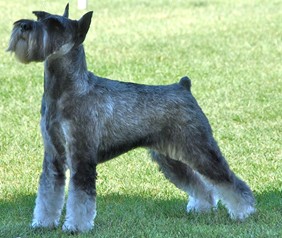
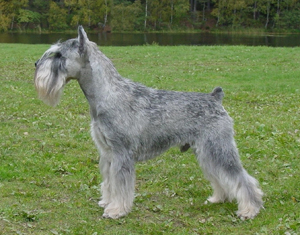


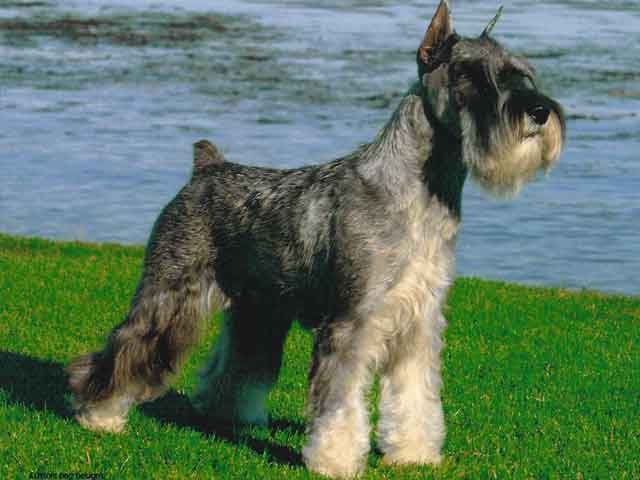


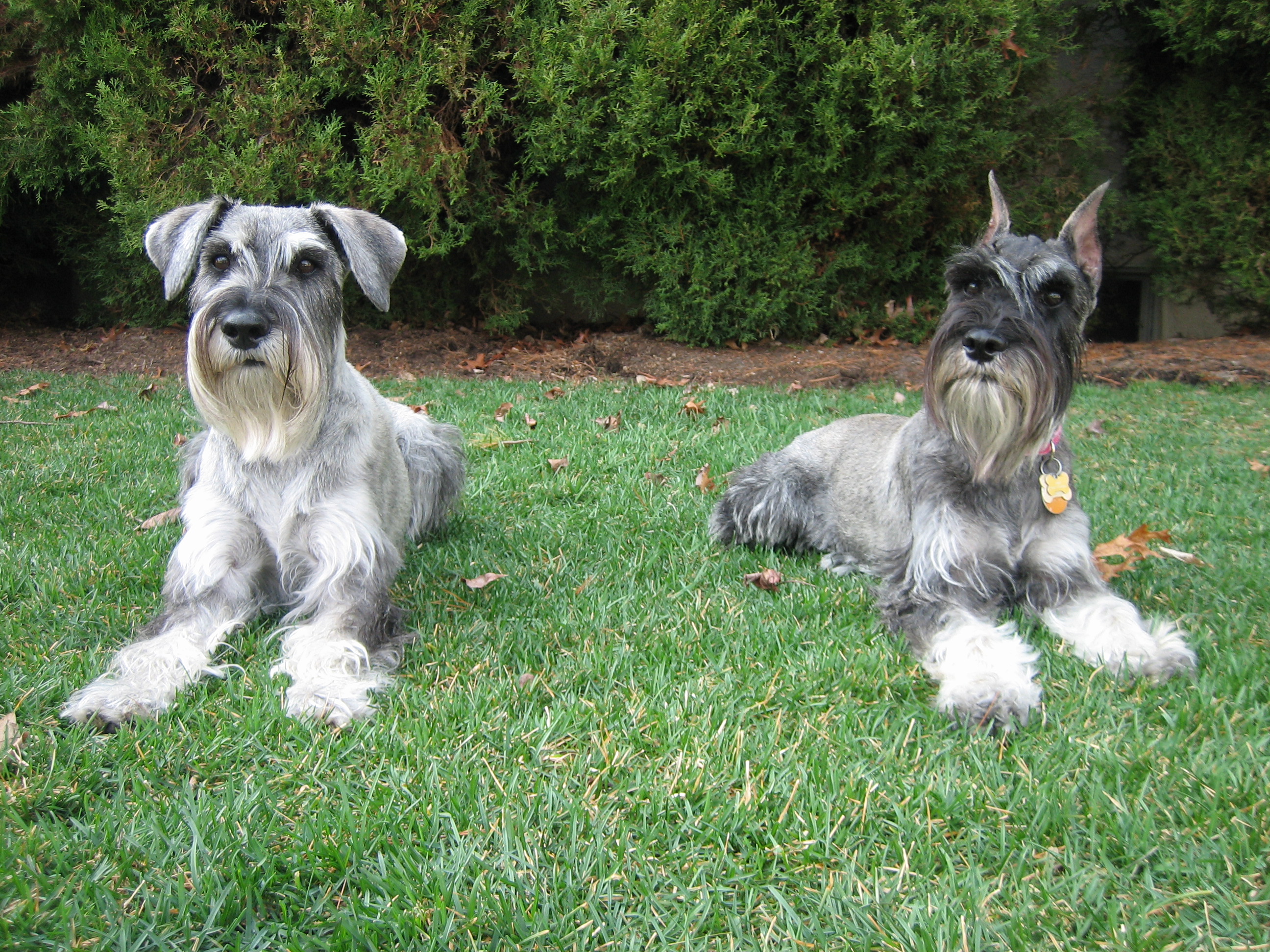
 Animalia Life
Animalia Life